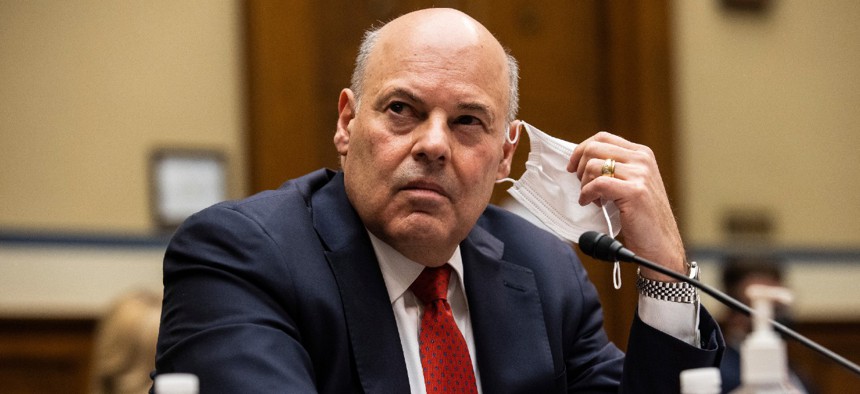
Postmaster General Louis DeJoy said he will listen to criticisms but hasn't heard any "viable alternative" to his proposed reforms. Graeme Jennings/Pool via AP
Postmaster General Vows to 'Consider' Critiques as USPS Announces Tanking Performance in Recent Months
Postal Service sees growing revenue, though losses persist as costs also soar.
The U.S. Postal Service saw improved financial results in its most recent quarterly filing, though its on-time delivery plummeted and significant concerns about its financial state persisted.
USPS lost just $82 million in the second quarter of fiscal 2021, a marked improvement over the same quarter the previous year. When excluding inflationary adjustments to the agency’s workers’ compensation liabilities that are outside of management’s control, however, the agency experienced $1.7 billion in losses from January through March compared to $1.9 billion in that period of fiscal 2020.
Total revenue jumped 6% over the same period last year, led by a 34% spike in package business. The shift from regular mail—where plummeting volume persisted—to packages continued to add costs to the postal system, as packages entail additional personnel and transportation costs.
Despite mail volumes declining, USPS delivered far less of it on time. Just 78% of First-Class Mail was delivered on time, compared to 92% in the second quarter last year. During a Board of Governors meeting on Friday, Scott Bombaugh, the Postal Service’s chief technology officer, attributed the delays to staffing shortages resulting from the COVID-19 pandemic and the demands of increased package business. Postal management, led by Postmaster General Louis DeJoy, has repeatedly argued the agency's delivery standards are no longer realistic and is currently in the process of slowing them down.
DeJoy announced the new delivery windows as part of his 10-year plan to bring USPS to a break-even point, parts of which won plaudits from some stakeholders but drew the ire of many congressional Democrats. The embattled postmaster general said he has received criticism both that his plan went too far and that it did not go far enough.
“So yes, I do hear the criticisms,” DeJoy said, “and I will consider them. But what I don’t hear is any viable alternative.”
DeJoy said he is most excited that his plan will “stabilize” the USPS workforce and reduce turnover of its non-career employees by 50%. The Postal Service has yet to spell out what specific workforce initiatives it will implement or commit to convert those workers to career positions. To date, DeJoy’s most notable workforce change has been seeking to slash the number of supervisors and administrative staff through early retirement offers and layoffs.
Ron Bloom, chairman of the USPS board, defended DeJoy’s plan, noting it “does not give everyone everything they want,” while suggesting such a feat would be impossible.
The Postal Service’s costs jumped by 4% in the most recent quarter, which management attributed to package delivery and paid leave related to the pandemic. The agency’s total net loss of $82 million was down from $4.5 billion in the same period last year.
Joe Corbett, the USPS chief financial officer, speculated the agency would break even by fiscal 2023 or fiscal 2024, provided DeJoy’s plan is implemented. USPS is relying in large part on Congress to pass reforms that would remove much of its liabilities for retiree health care costs from its balance sheets.
Fredric Rolando, president of the National Association of Letters Carriers, said the postal revenue increases demonstrate those retiree health care reforms are the primary change needed.
The uptick in business drives home “how much the American people and their businesses rely on the essential work of the Postal Service,” Rolando said.







